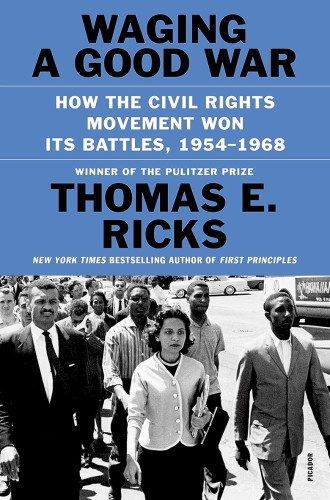In Waging a Good War, Thomas Ricks offers a novel interpretation of the civil rights movement as a kind of war—a series of campaigns on carefully chosen ground that eventually led to victory. Ricks, who has written books about World War II, Korea, and Vietnam, now brings his experience as a war correspondent in Somalia, Bosnia, Afghanistan, and Iraq to bear on his analysis of the strategy and tactics of the civil rights movement. By couching key moments in military terms, he deftly narrates the successes and setbacks that resulted in the United States becoming a genuine democracy for the first time in its history.
“The Siege of Montgomery. The Battle of Birmingham. The March on Washington. The frontal assault at Selma.” While this language may seem jarring at first, given the movement’s association with nonviolent resistance, it clarifies the strategic thinking and organized effort at the heart of the struggle for civil rights for Black Americans. The military history approach is helpful, even imperative, Ricks argues, for understanding and applying the lessons of the movement to politics today—including efforts to restore the voting gains of the 1960s.
Read our latest issue or browse back issues.
“From 1955 to 1968 a disciplined mass of people waged a concerted, organized struggle in dedication to a cause greater than themselves,” he writes. “In conducting their campaigns, activists made life-changing decisions with inadequate information while operating under wrenching stress and often facing violent attacks—circumstances that are similar to the nature of leadership in war.” It’s reasonable to consider the civil rights movement America’s “good war” and its activists our “greatest generation,” Ricks notes, citing historian Peter Onuf. “The sacrifices of Movement leaders and rank-and-file members led to a realized, if imperfect, democracy.”
In Ricks’s telling, the Freedom Rides of 1961 are a classic example of a long-range raid behind enemy lines. The problems that plagued the desegregation campaign in Albany, Georgia, the following summer demonstrate how a clever, adaptive enemy can stymie an offensive. Ricks treats Mississippi’s Freedom Summer as a calculated campaign to expose privileged White northerners to the same risks of violence that Black southerners daily endured. “The Montgomery bus boycott was primarily defensive, in that it was a withdrawal of patronage, while the Nashville sit-ins were offensive in that they were demands for service,” he writes.
Some of the historic parallels Ricks draws are strained, as when he likens the Freedom Riders to the Doolittle Raid, the American bombing attack on Japan early in World War II. Not so when he compares the intense training and discipline of civil rights activists—which he attributes in large part to James Lawson’s influence on the movement—to the preparation of soldiers for combat. “The civil rights movement was often creative, but it was rarely spontaneous. Its members did not just take to the streets to see what would happen. Rather, weeks and even months of planning and preparation went into most of its campaigns.” While Ricks notes the significance of visible actions such as marches, speeches, and other public events, the focus of Waging a Good War is on the extensive planning, strategic thinking, and reconnaissance that were fundamental to the success of civil rights campaigns.
This is where the book serves as more than a history of the movement, suggesting as it does that a similar dedication to planning and strategic thinking will be essential to defeating those who would roll back civil rights gains. Ricks notes that today the same antidemocratic faction that opposed the civil rights movement is resurgent, seeking to restrict access to the vote and pass laws limiting the ability of teachers to teach history. Meanwhile, he writes, “right-wing American oligarchs have poured money into politics, effectively undercutting the power of the vote.”
If America is to have what “most Americans want—a multiracial, multiethnic democracy,” Ricks argues, “we will need to renew the promise of the peaceful voting rights crusade.” Renewing that promise will require a similar commitment to strategic thinking, disciplined action, effective organization, and perseverance as demonstrated by the civil rights generation. Waging a Good War is a smart guide to what it takes to maintain a multiethnic democracy in the United States.






